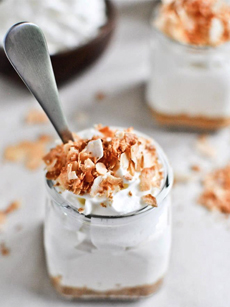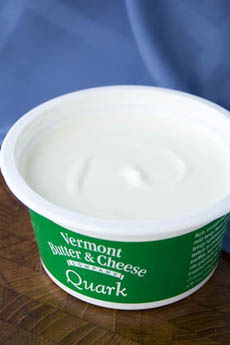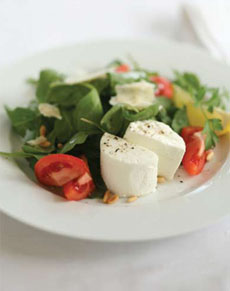
[1] Quark can be eaten like yogurt or used as a bread spread and in recipes (photo © Vermont Creamery).

[2] Pancakes with savory garnish: quark cheese and marinated cherry tomatoes (photo © Wisconsin Cheese).
|
|
If you like yogurt—or even if you don’t—try quark cheese. It’s smooth and creamy like Greek yogurt or sour cream.
In fact, quark has approximately the same amount of calories, but a richer flavor, than low-fat sour cream. So it’s a real find for your baked potato and chili.
WHAT IS QUARK?
Quark is a soft, unripened (fresh) cow’s milk cheese. In North America, the recipe is almost identical to fromage blanc, except that fromage blanc is totally fat-free.
Quark is so popular in Germany that it accounts for almost half of that country’s total cheese production: The average German eats about 10 pounds of quark a year.
You can find quark in every German market. But it’s a different style of quark (details below).
In other parts of Europe, quark is also known as koarg, kwark, qwark, quarg, twarog, saurmilchquark, speisequark and fromage frais.
In the U.S. and Canada, quark has yet to catch on. It’s only made by artisan dairies, and some dairies make 2% and fat-free versions in addition to full-fat quark.
The next time you see it, take it home and see how it enriches your daily dining. If you can’t find it locally, you can buy it online.
January 19th is World Quark Cheese Day.
> The history of cheese.
> The different types of cheese: a glossary.
|
THE CONFUSION OVER QUARK: OLD WORLD VS. NEW WORLD STYLES
Quark is the German word for curds; curds are coagulated milk. Some definitions translate it as “cottage cheese.”
However, neither American nor European quark resembles what Americans know as cottage cheese, with recognizable curds. With quark, the curd consistency is smooth, like curdled milk (see photo below).
|
|
In Europe, some or most of the whey is removed by hanging the quark in cheesecloth and letting the whey drip off, to achieve the desired thickness. This gives artisan (handmade) European quark its distinctive shape of a wedge with rounded edges.
In commercial production it is formed into blocks with the consistency of ricotta or pot cheese.
In the United States and Canada, quark is a somewhat different product, most often sold in plastic tubs with most or all of the whey.
This creates a style that has the texture of yogurt or sour cream: a denser, more spreadable consistency. The texture of domestic quarks varies by the preference of the producer.
HOW TO ENJOY QUARK
Both European and American styles are eaten the same way.
Quark can be eaten like yogurt, plain, or blended with fruit or jam. In Germany, it is mixed with chives as a bread spread.
Use it to top a baked potato or chili, as a soup garnish, or anywhere you’d like a hit of yogurt or sour cream. Use it to make a creamy sauce: Unlike yogurt, the heat won’t curdle it.
On the sweet side, quark is a popular ingredient in filled pastries, sweet sauces, soufflés, cheesecakes, and mousses.
|
|

[3] American style, creamy quark from Vermont Creamery (photo by Claire Freierman © THE NIBBLE).
|
Scientific-oriented people may wonder why a cheese is named after subatomic particles. We explain that in the footnote below.
More about quark and other fresh cheeses, including crème fraîche, fromage blanc, labné, mascarpone and queso fresco.
_______________
*In German, Quark and Topfen, the names of cheeses, are also used to mean “nonsense.” This latter usage is believed to be an inspiration for the passage written by James Joyce in his fanciful novel, Finnegan’s Wake: “Three quarks for Muster Mark!/Sure he hasn’t got much of a bark/And sure any he has it’s all beside the mark.”
This excerpt is from a 13-line poem directed against King Mark, the cuckolded husband in the Tristan and Isolde (Iseult) legend. The use of the word “quark” to describe elementary particles of matter was taken from this poem by Murray Gell-Mann, the physicist who received the 1969 Nobel Prize for his work in classifying quarks. The allusion to three quarks seemed perfect to him, since originally there were only three subatomic quarks.
CHECK OUT WHAT’S HAPPENING ON OUR HOME PAGE, THENIBBLE.COM.
|
|







